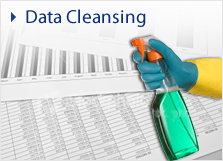Assess prospect data accuracy
The fact is, your prospect database is only as good as the accuracy of the data, and it is a never-ending task keeping the data clean and current. People move around from job to job and company to company; companies are acquired or merge.
Often your prospect database is inherited from those who came before you. It is frequently a jerry-rigged compilation of data from different departments, with little consistency in the type of data being collected. Until you standardize your database, it will continually create gaps in your marketing efforts. Because database clean-up is a huge headache, the tendency to delay dealing with it is sometimes irresistible. However, it is well worth going to the trouble of addressing data issues. In our observation, good clean data is fundamental to the effectiveness of any B2B campaign and will dramatically improve the response rates and cost effectiveness of your demand generation efforts.
Steps to increase your database ROI:
- Carry out a data discovery and audit exercise at your company to find all the wells of data you may have, and get a data hygiene executive report on its usability.
- At DMP, we can run our client’s data through a data formal assessment automation tool. It comes back with a grading report indicating the percentage of good vs bad data so we can create a plan. This includes contact, phone number and email. Knowing the good/bad percentage ratio up front helps set expectations.
- Purchase additional data overlays to fill the gaps in your existing prospect list.
- Segment: Once you’ve created a clean database, analyze and segment your data. This will help you to maximize the relationship-building potential of your campaigns.
Bonus Tip A: The above can be tedious and time consuming. To keep your sanity, consider outsourcing the heavy lifting and manipulation work on your marketing database to an experienced service provider.
Bonus Tip B: Don’t boil the ocean. It’s a great deal easier to segment your target markets into smaller, more manageable groups than it is to try and address all markets at the same time. The most relevant segmentation is to customize your message by whether the individual is a customer or a prospect. A customer should be treated and addressed as such, or you risk insulting him/her. Secondly, segment by industry, company size and prospect title or job function.
Compare campaign performance by segment to identify which segments perform the best. Historically, smaller, well-focused campaigns outperform larger, less-targeted ones.
Be sure and filter inbound responses into your segments and monitor the touch quotas. By cleaning and segmenting your data, you are likely to see fewer touches required for conversion, leading to less costly campaigns overall.
